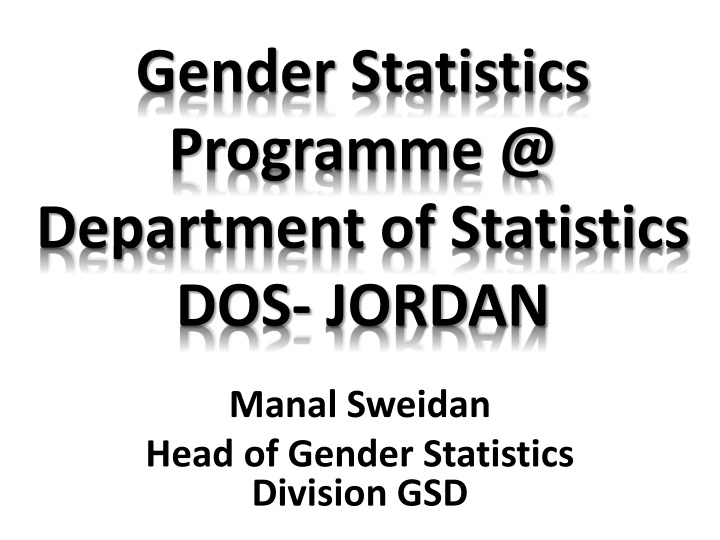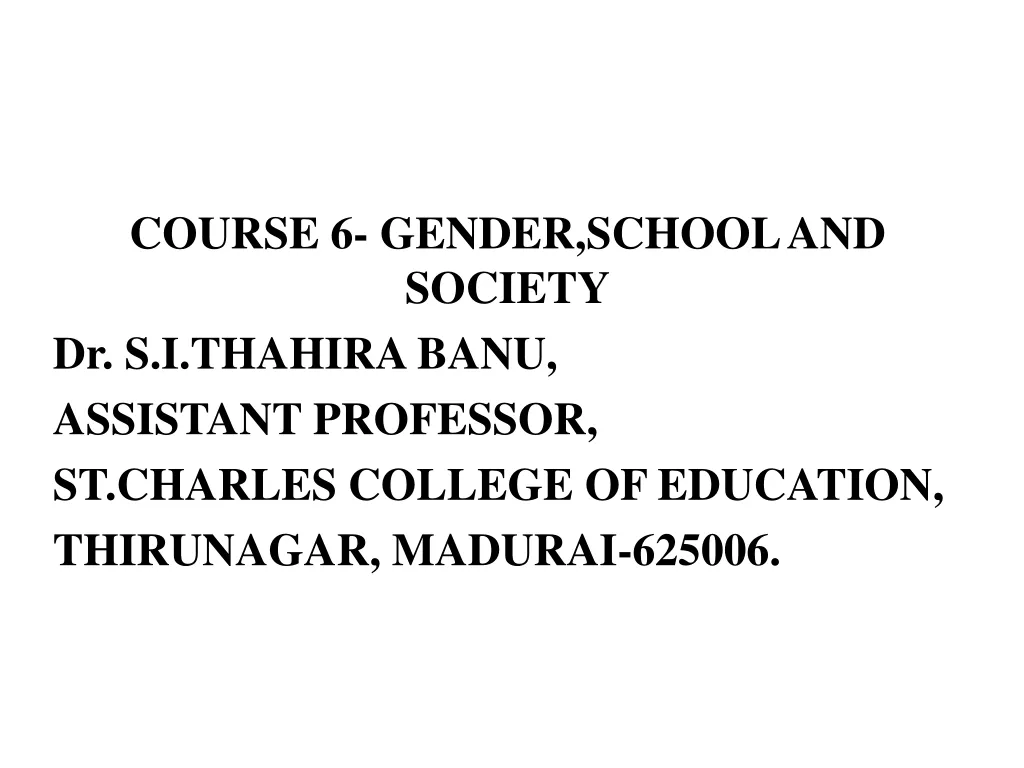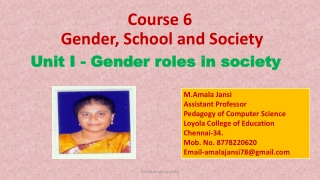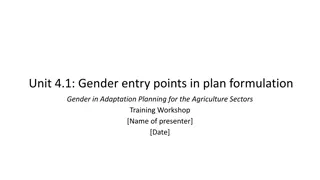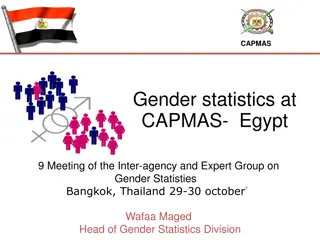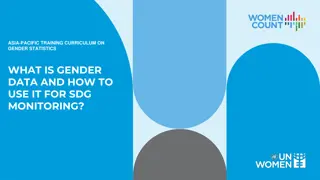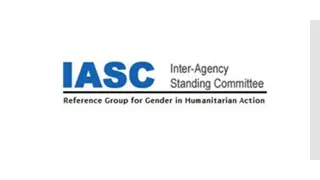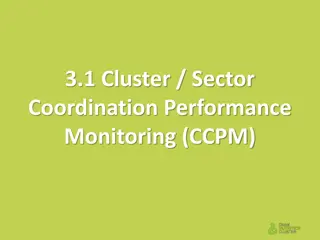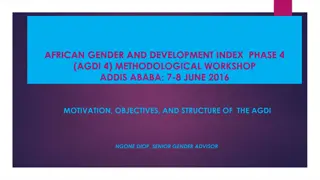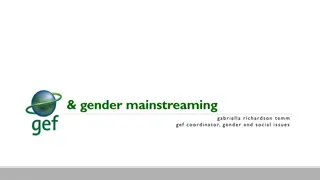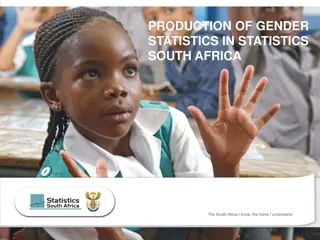Gender Statistics Programme at Department of Statistics
The Gender Statistics Programme at the Department of Statistics in Jordan, led by Manal Sweidan, focuses on providing comprehensive indicators to monitor gender issues globally, regionally, and nationally. The programme covers various domains such as Household Expenditure, Income, Information Technology, Education, Law, Population, Political Participation, Health, Economy, and more. It aims to support data users and policymakers in understanding and addressing gender disparities effectively.
Download Presentation

Please find below an Image/Link to download the presentation.
The content on the website is provided AS IS for your information and personal use only. It may not be sold, licensed, or shared on other websites without obtaining consent from the author.If you encounter any issues during the download, it is possible that the publisher has removed the file from their server.
You are allowed to download the files provided on this website for personal or commercial use, subject to the condition that they are used lawfully. All files are the property of their respective owners.
The content on the website is provided AS IS for your information and personal use only. It may not be sold, licensed, or shared on other websites without obtaining consent from the author.
E N D
Presentation Transcript
Gender Statistics Programme @ Department of Statistics DOS- JORDAN Manal Sweidan Head of Gender Statistics Division GSD
Domains of Gender Statistics all indicators are available to provide a basis for monitoring gender issues on the global, regional and national levels. Indicators reflect relevant BPA strategic objective & the Millennium Development Goals as well as the SDG5 Household Expenditure & Income Information Technology Education Higher Education Law Population Political Participation Health Economy (Empowerment+ Economic Participation) Social Disaggregated by Sex
Domains of Gender Statistics by Source Information Technology 100 political participation 100 Economic Empowerment 100 DOS Surveys Economic Participation 100 Health 80 20 Administrative records Higher Education 100 Education 18 82 Social 100 Population 100
Parliamentarians Policy makers Government Authorities Data Users the Media Researchers Civil society organizations & Women s Machinery International bodies
Electronic Provision of Data Gender Statistics Web- links at DOS website Static links Dynamic Links Data bank Women's statistics Women & men statistics
Gender statistics web-links @ DOS website English Language
Gender Statistics link at DOS website Static links Women & men statistics Women's statistics
Electronic provision of data Gender Statistics link at DOS website Dynamic Link Online Data Bank
Arab Gender Statistics Framework - GIsIn The Statistical Policies and Coordination Unit at ESCWA developed the Regional Gender Statistics Framework (GIsIn) in 2009 in collaboration with Member States to serve as an official transparent source with metadata to meet the needs of users from national and international communities. The framework facilitates the use of a common language with regard to measurement of priority issues at the sub national, national, regional and international levels GIsIn is a 3-D framework links MDG framework, with BPoA in 12 areas, and includes quantitative and qualitative indicators - In 2014, ESCWA Statistical Division in collaboration with Member States finalized updating of Arab GIsIn including alignment with UNSD core set of indicators and EDGE initiative
Distribution of indicators in the ESCWA Framework The ESCWA framework includes 103 indicators (88 quantitative indicators and 15 qualitative indicators) Framework Indicators by Type and Tier based on the Jordanian context Quantitative Indicators Tier 1 Tier 2 Tier 3 Qualitative Indicators Total Total 79 6 3 88 15 103 Tier 1: indicators are available and calculated and published in the reports / databases Tier 2:indicators are available but unpublished it can be calculated or collected from sources available and disseminated to be made available in the near future Tier 3:indicators to be collected with the use of new tools.
Next steps for AGS Framework Preparing a database reflecting all the indicators in tier one of the AGS framework. Contacting all potential data producers for tier two indicators. In addition, unofficial contact with some of international institutions has been done to work on the provision of funding for the surveys that provide indicators related to tier three.
Availability of Minimum set of gender indicators, by domain Avaliable Not avaliable Human rights of women and the girl child 75.0 25.0 Public life and decision-making 80.0 20.0 Health and related services 69.2 30.8 Education 100 Economic structures 68.2 31.8
Reasons for Data Gaps Domain Percentage of not available indicators 31.8 Reasons No available specialized surveys such as Time use Survey to provide such indicators Economic Structures Health and related services Human rights of women and the girl child 30.8 Data is not collected from administrative records No available specialized surveys on Gender Based Violence (quantitative and qualitative indicators) and the data is only available from DHS survey 25 Public life and decision-making 20 The data is not accessible for security issues
Availability of SDG Indicators for Goal 5. Achieve gender equality and empower all women and girls Whether or not legal frameworks are in place to promote equality and nondiscrimination on the basis of sex Proportion of ever-partnered women and girls (aged 15-49) subjected to physical and/or sexual violence by a current or former intimate partner, in the last 12 months Proportion of women and girls (aged 15-49) subjected to sexual violence by persons other than an intimate partner, since age 15 Percentage of women aged 20-24 who were married or in a union by age 18 Percentage of girls and women aged 15-49 years who have undergone FGM/C Average daily (24 hours) spent on unpaid domestic and care work, by sex, age and location (for individuals five years and above) (yellow color) Percentage of seats held by women in national parliament Proportion of seats held by women in local governments Not available Available Not relevant
Availability of SDG Indicators for Goal 5. Achieve gender equality and empower all women and girls Proportion of women (aged 15-49) who make their own sexual and reproductive decisions. [Proportion of countries with laws and regulations that guarantee all women and adolescents access to sexual and reproductive health services, information and education (official records) Share of women among agricultural land owners by age and location (U/R) (yellow color) The legal framework includes special measures to guarantee women's equal rights to land ownership and control. Proportion of individuals who own a mobile telephone, by sex Percentage of countries with systems to track and make public allocations for gender equality and women s empowerment Availabl e Not available
Next Steps Population and Housing Census, 2015 THE CENSUS METHOD All housing units in the Kingdom will be visited with the aim to conduct direct interviews with the residing households. Data is going to be collected through using electronic questionnaires especially designed for this purpose. What distinguishes this CENSUS? The General Population and Housing Census 2015 will be implemented with the help of latest modern technology that assist in accurate and fast performance. TABLETS will be used to collect the statistical data from the household and transfer them to the databases.
Gender issues reflected in the population census questionnaire Age at first marriage Maternal mortality Ownership of land by the Household Head Characteristics of refugee women Characteristics of disabled women Economic Participation of women Girl child labor In addition to the demographic characteristic like Age, Education, Medical insurance, Marital status, Internal migration, Religion and Nationality.
Thanks for Listening
